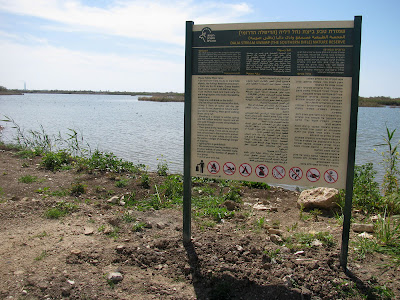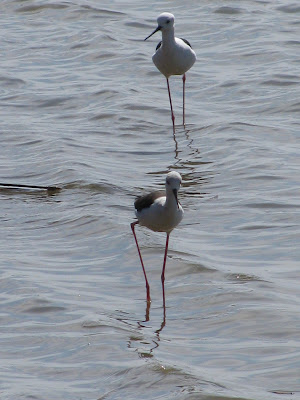The hill is in bloom for most months of the year, depending on the season. The common anemone can be seen there between December and March, autumn narcissus between November and December, common cyclamen between October and June, Barbary nut between January and April, and Palestine iris between December and February. Mister Handmade in Israel and I visited the hill last March hoping to see the aforementioned mountain tulips, which supposedly bloom between February and April, but there were none to be seen. It was still a beautiful site though and unique in the amount of blooms in such a small area.
The hill is maintained by kibbutz Ma'agan Michael and the Society for the Protection of Nature in Israel (SPNI). The narrow paths between the flower clusters are clearly marked and signs explain the history of the area. One such sign pointed out the cistern, above, dug in a low area of the hill for the purpose of trapping rainwater. The sides of the cistern were plastered to prevent water seepage.
Ma'agan, from Ma'agan Michael, means anchorage. Founder members of the kibbutz planned to settle on the seashore, motivated by the dream of establishing a Jewish fishing industry. The second part of the name comes from Michael Pollack, a Jewish industrialist from Russia and founder of the Nesher cement plant.The columbarium dates back to the Roman Byzantine period and is carved with niches.
I was excited to see a two Egyptian mongoose near the water's edge, above. The Egyptian mongoose is the only species of mongoose present in Israel. This species lives in non-desert habitats in most of Africa, southern Spain, and east throughout Israel and Egypt. In Israel they are common wherever there is water.
We drove further up the road, past the fishing ponds of kibbutz Ma'ayan Zvi. The kibbutz was established in 1938 as part of the tower and stockade settlement project by members of the Maccabi youth movement who fled from Nazi Germany. At first it was called Ma'ayan but in 1945 the name Zvi was added in honor of Zvi Frank, a Zionist activist and one of the heads of the Jewish Colonization Association which purchased the kibbutz lands.
We arrived at the Dalia Stream Swamp Nature Reserve, above, part of the contiguous moist habitats that once extended along the Carmel coastal plain. The natural water comes from the springs that emerge along the kurkar ridge east of the swamp. Thanks to these interesting conditions, the swamp has become a nature reserve, home to an aquatic plant called hornwort, in addition to the rare Phoenician rose, Spear-leaved Dogbane and saltmarsh morning glory. The nature reserve and the fishponds attract many aquatic birds and support a wide variety of animals, among them softshell turtles.
All attempts to transform the swamp into fishponds have failed due to the springs that impede regulation of the water level. The reserve is presently in the midst of a lengthy and significant rehabilitation process to improve its ecological and biological functioning.
About 3km south of the Dalia river swamp a steel pipeline enters the sea. It's purpose is to drain the fishponds into the sea and keep the pond water 300m from the beach.
Egyptian mongoose
The grey, slinky animal lives in territories and eats a variety of prey including insects, snails, birds, amphibians and reptiles. Of course, mongoose are famous for preying on snakes, and in particular venomous snakes. "Rikki-Tikki-Tavi" is a short story published in 1893 by Rudyard Kipling as part of a collection of short stories titled The Jungle Book. Rikki-Tikki is a mongoose, and this short story follows him on a crusade to protect a family and their garden from two very aggressive, huge black cobra snakes.
Our last stop of the day was at Hof Ma'ayan Zvi which, despite the rough and bumpy gravel road leading to the beach, is definitely worth a visit. The beach is quiet, beautiful and isolated - a hidden gem waiting to be explored.
We stayed for two nights at the Smadar Hotel and Winery, above, located on Zichron Ya'akov's old cobbled Hameyasdim Street. The Smadar Winery is a boutique winery in the courtyard of a stone house built in 1890. The winery makes aged red wines from vineyards that have been cultivated by the family for five generations. The hotel offers a heated indoor swimming pool, below, and rooms that overlook the small gardens. It was a lovely place for a short break.
* This post has been shared on The Good. The Random. The Fun., Wordless Wednesday (on Tuesday), Tuesday Turn About, Wild Bird Wednesday, My Corner of the World and Mosaic Monday.






























.png)


























25 comments:
Such beautiful pictures. :)
Annie,
Annies Food Diary
I always enjoy reading your travel posts. The colour of the sand on the beach is amazing - it looks so clean :)
#MMBC
What a beautiful place to visit, the flowers and the view! How interesting to read all about it. That hotel is so cute!
Wow - adding this to my list of place to visit in Israel!
What a beautiful walk one could enjoy there! I love the 5 generations of the family tending the vines to make wine. Thanks for the tour, you always do a great job! #MMBC
...thanks for taking me along on your nature walk!
I love when you take us on an excursion. Today's nature walk was beautiful...... #MMBC
Your photos are lovely! It sounds like you had a really wonderful day of exploring. Rikki Tikki Tavi was one of my boys' favorite books. I think we checked out that book every other week from our local library.
Really enjoyed this post, a perfect getaway and hike -- combination of scenery, wildflowers, and wild animals (I had to enlarge the mongoose -- at first glance, it looked like a log!) ... plus the bonus of interesting history . The columbarium was fascinating; it is always so good to be reminded of the daily lives of people in ancient history -- raising food, farming, and so forth.
Such interesting places and stunning scenery. I've only ever seen a mongoose in a zoo (where I expected the plural to be mongeese but it is actually mongooses!), so I'm very envious that you saw them in the wild. I could imagine pigeons being kept in those little holes, they look just like the inside of dovecotes. What a lovely break; thank you for taking us along. xx
What a beautiful place! The mix of seasonal blooms, wildlife, and history makes Tulip Hill and the Dalia Stream Swamp so special. Seeing the Egyptian mongooses is amazing! Thanks for sharing—this sounds like a hidden gem worth visiting.
What a lovely exploration of the area. It's interesting how you've woven together the natural landscape with the historical context of the kibbutzim and Roman-era structures.
Thank you for sharing such a detailed review I love learning about the history of places around the world. Your photo's are beautiful.
How fascinating that all those flowers, especially the rare ones grow on that hill. And I love the water fowl and mongosse.
The graceful, long legs of the wading birds keep the birds well above the water line. But the legs are sooo spindly, they look as if they could break in an instant.
The pattern on those crumbled rocks and ancient ruins is fascinating.
What a lovely walk - if only I could visit there myself!
Oh I just love these wonderful informative shares about Israel. Such a beautiful place. Praying for peace. Am Yisrael Chai!!!
Amazing stones
Interesting, I enjoyed reading very much. Yes, stones can telling, indeed I believe it.
Thank you for sharing and for being part at MosaicMonday.
You found such interesting things. That columbarium in so intriguing. And the winery sounds amazing
Interesting for me! Indeed I love to read about Israel. It's Sunday afternoon, it's a good time to write comments...
...I am again very pleased about your participation in MosaicMonday.
What a lovely tour, thank you for showing us more of your wonderful Country. I have to admit though, I had to do a double take on your photo of the Egyptian Mongoose as I thought it was a log :)
Such a peaceful, beautiful place, Lisa! Some of it is not dissimilar to our Algarve, but I'd love to see the wild tulips, and the Columbarium is completely outside of my experience. Thanks so much for sharing. Good to know that you are doing well.
Lisa, thank you for sharing your wonderful post with us. We're featuring your post tomorrow at The Crazy Little Lovebirds link party.
Post a Comment